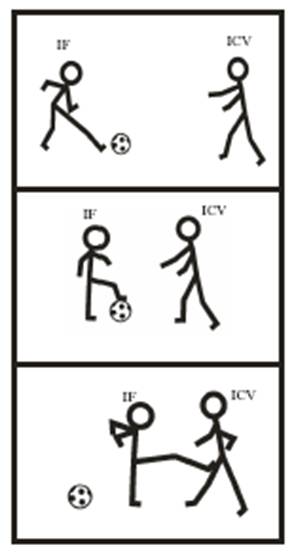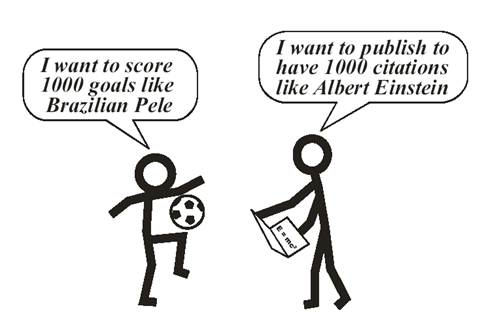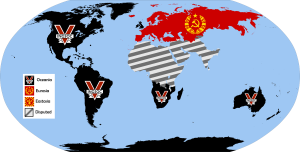by Victor Adedayo
Abstract
This paper uses analogies to establish visualized connections between football and citation analysis as used to compute impact factor in academic publishing. Shaolin Soccer (2001), the comedy film written and directed by Stephen Chow was particularly used for some analogies. The role and importance of analogy in scientific communication is identified. The popularity and well grasped knowledge of the game of football is exploited and used to paint graphic illustrations of the purpose of citation. Amongst other reasons, citation may be used to give credit to the primary literature; however, this is not the absolute purpose. Citations can also be made to discredit. There is need for the organizations concerned with evaluation of published scientific articles to be more careful and transparent in the processes used to evaluate publications of scientific communications.
Keywords: Analogy, Football, Citation Analysis, Impact Factor, Scientific Communication
Introduction
Analog refers to the cognitive process of transferring meaning from a particular situation/process to another particular situation/process to establish similarity between the two situations. In cognitive psychology, analogy is considered an important method of problem solving (Dawson and Medler, 2009). Analogical reasoning occupies the central role in human cognition. The ancient Greek philosophers recognized, discussed and wrote about the importance of analogical processes in many aspects of life. In a more specific way, analogies are inferences or arguments from one subject to the other, used to enhance understanding in concept learning. They are excellent communication tools used to explain abstract and difficult ideas (Dagher, 1995; Duit, 1991).
When new concepts are introduced, meaningful learning ensues when there are visualized connections between the newly taught concept and what is already known. Analogies are used to establish these connections. Models of analogy are common in science communication (Harrison and de Jong, 2004), and help scientists understand and communicate the intricacies of their observations. They are successful science thinking tools by scientists (Dagher, 1995). For example; Niels Bohrs made an analogy between the structure of an atom and the solar system. The use of analogy in academic journal articles is also common and well documented (Bunge, 1981; Felty, 1985; Bonneau, 1987; McCullough, 1980)
Citation analysis are now increasingly used as a metric of evaluation in a number of academic endeavours based on the enumeration and statistical analysis of scientific output in the form of articles, publications, citation and other more complex indicator (Okubo, 1997). Sharma et al., (2013) and Lowy, (1997) identified that promotion and grants receptions in the US and UK are based on results of evaluation, as well as how many times an institution has been cited in publications.
The frequency of citation can be used to compute the Impact Factor (IF), which is taken as an index of quality of the published research (Thorston-Krell, 2012). Albeit, it is very important to understand that IF has a number of well documented deficiencies. It was singled out in the 2013 San Francisco Declaration on Research Assessment (DoRA) to address the deficiencies (Thomson Reuters, 2014; DoRA, 2013). DoRA (2013) particularly identified that citation distributions within journals can be highly skewed. These deficiencies are manifestations of an incorrect assumption in the conceptualization of the purpose of citation.
In this particular write up, analogies of football are used to identify the intricacies in citation. The erroneous conceptualization of the purpose of citation as used in citation analysis to evaluate the quality of research articles is identified. This paper makes attempt to clearly identify the purpose of citation so as to set right the concept of purpose of citation. A call for fair play in the citation analysis game is also made.
Why Football?
There is a documented clear analogy between citation and game. The PLoS Medicine Editors made analogous assertion of similarity between citation analysis and game with the title of their published article: The impact factor game (The PLoS Medicine Editors, 2006).
If concept learning must take place, appropriate analogies must be used. The analogies must build a link between a well grasped familiar knowledge and the new concept to be learned (Harrison and de Jong, 2004). Football, also popularly referred to as Soccer, is by far the most popular sport in the world in terms of fans (Topend Sport, 2014) (See Figure 1). About 265 million male and female actively play the game, in addition to 5 million referees and officials. This makes a grand total of 270 million people who are directly involved in the game (FIFA, 2007). Also, it has been estimated that football has about 3.5 billion fans worldwide (Topend Sport, 2014).

Figure 1: Influence of Football (IF)
This popularity ensures a widespread and well grasped knowledge of the game. Visualized connections built between football and the concept of the purpose of citation in scientific communication will be well grasped. The objective of scientific communication is to solicit support for science research or to enhance informed decision making, including political and ethical thinking (see Figure 2.). Authors of scientific communications can use entertainment and persuasion including satire/humour, storytelling, and metaphors (Grushkin, 2010; Miller, 2008).

Figure 2: Important Future (IF)
The Citation Problem
Originally, citations were designed by librarians for information retrieval (Okubo, 1997). However, now, derivations of citation analysis are increasingly used as metrics to evaluate performance in a number of academic endeavours. Using citation frequency for performance metrics was based upon the false premise that the purpose of citation is to give credit to the primary source of information. While giving credit to the primary literature may be one of the purposes of citation, this, however, is not the only purpose. Citations can also be made to discredit the primary source. Other purposes include: to avoid plagiarism, and to allow readers determine independently whether the cited source supports the arguments in the way claimed.
In using citation analysis to compute metric used for evaluation of scientific communications, generally, there is a count of the number of citations to all parts of the journal and the number of papers. All citations in any section of the article are counted (Garfield, 1992). But should citation be used to measure quality?
Actually, a definition of quality should indicate excellence and superiority with connotations of high degree of approval because it is free of errors (Adedayo, 2013; Adedayo, 2014). Only citations that express approval of the science communicator should count for quality. Discredited citation should not count for quality; however, they may be used otherwise.
Football Analogies
As a way of analogy, let’s say scientific publishing is like a player in a football game. The player may score the ball, and he may score the ball severally. Also, he may score the ball with great skills of dynamism of athleticism so that he receives a great ovation that people everywhere talk about him.
Similarly, when a scientist writes a paper and it gets published, then he has scored the ball. When he publishes severally, he has scored the ball severally. If he is published and gets cited, then he has scored the ball and he is being talked about and has received an ovation.
Sadly also, a player may mistakenly kick the ball into his own goal post. This way, people may talk derogatorily about him. Similarly, one gets published but the paper is cited as a bad example. A striker player, who has many goal opportunities and is not able to convert any of the opportunities to goals, will also inspire derogatory comments. This could be likened to a scientist that receives adequate funding for research but yet cannot conduct an effective research. When such scientists get published, the published articles can be cited, however, citations are made to indicate insufficiency, laxity and/or flaws in the research results. Authors of review articles may also get cited despite the fact that they are not the primary source of information. Reports of citation analysis actually confirmed that some review articles get more citations than the primary literatures. Authors of review articles are like skilled dribbler players that play just to entertain. They are being talked about in a good way despite not having converted any goals.
The funds that accrue to a football player are functions of his performance in the past matches where he played. Grants receptions are also based on impact ratings as well as how many times an author of a scientific article has been cited in his previous publications (Daniel, 2013; Seglen, 1997; Lowy, 1997).
In a football game, there are the officials. Normally, there is the referee who is assisted by two assistant referees (formerly called linesmen). The roles of the referees in football games are crucial. The attitude of the referees in the use of red cards and yellow cards during football matches can greatly impair or aid the success of a team. Referees may be partial or impartial.

Figure 3: Impact Factor (IF)
The fairness of the game does not solely rely on the player; it also depends on the ability of the referees to remain impartial. Similarly, organizations like Thomson Reuters and Index Copernicus International play a crucial role in scientific communications. There has been so much agitation on the published citation reports. For example, Rossner et al., (2007) demanded transparency with their article titled: ‘Show me the Data!’ Also, DoRA, (2013) identified a number of well documented deficiencies of Impact Factor and suggested that the data used to compute Impact Factor should be openly available. There is need for fairness and transparency on the use of metric tools to evaluate scientific communications (Rossner et al., 2007, Editorial, 2005, The PLoS Medicine Editors, 2006).
There remains great similarity between academic publishing and football. In football, there’s the football league system. League one, League two. For example, there’s the Premier League. It is the big league where clubs like Chelsea, Man U, Arsenal etc play against each other. Also, in the academics, we have leagues. There’s a minor publishing league such as student association journals, and there’s the very big leagues such as Annalen der Physik where super stars like Albert Einstein published. There’s also the Ivy League in academics.
Shaolin Soccer
Shaolin is a very popular Chinese word which is closely related to the Chinese martials arts. The Shaolin Temple located on the Songshan mountain range in China was founded around the fifth century, and is long famous for its association with Chinese martial arts, especially with Shaolin Kung Fu. Kung Fu can refer to any study, learning, or practice that requires patience, energy, and time (Wikipedia, 2014; Yang, 1989). One of the symbols of Kung Fu is the T’ai Chi Ch’uan. The T’ai Chi Ch’uan is a rounded black and white symbol that resembles a football (See figure 4).

Figure 4: T’ai Chi Ch’uan is the black and white Kung Fu symbol. It represents Interdependent Forces (IF)
The symbol represents the union of Yin and Yang, which are the two fundamental principles of nature. Chinese philosophers believe in the origin of the universe as explained by Yin-Yang theory. Yang and Yin are considered two natural opposing principles that exist together. Yin denotes black, while Yang represent white. “Black and White” is a term that can be used to refer to a situation involving clearly defined opposing principles or issues. “Black and White” can also be used to refer to the written word (Longman, 2005 ). Similarly, in academic writing, citations can be made to indicate positive opinions, and at the same time, citations could be made to indicate negative opinions. The belief that citation to an article signifies quality is borne out of the opinion that citation of an article establishes a positive approval. This opinion, in general, is not true. It should be pointed out that not all citations to an article actually count for quality. Sometimes articles are cited to point out important conflicting ideas, or to identify errors or the sources of errors. Particularly, in writing the literature review, the purpose is to convey knowledge and ideas that have been published relevant to the subject of interest. Identification of the gaps, opposing views, strengths and weaknesses of the published knowledge is made (Emerald, 2012).
In Shaolin Soccer (2001), the comedy film written and directed by Stephen Chow, the opening clip of the film shows a teenage boy who had the opportunity of a penalty shoot-out. The spectators were of high hopes expecting a goal. Unfortunately, the boy kicked the ball over the bar and lost the goal opportunity. There was reaction from the spectators. They commented, however, negatively. The spectators became outrageous.
This could be likened to a scientist that has enough infrastructures and receives adequate funding for research but yet cannot conduct an effective research. When such scientists get published, the published articles can be cited, however, citations are made to indicate insufficiency, laxity and/or flaws in the research results.
Shaolin Soccer was marked with initial foul-plays (See Figure 5). Engineer players came to the field with hidden spanners and hammers, while doctors secretly gave their players injections of performing enhancement drugs injections. These serious rough plays continued until Shaolin team played in a match against the Evil team. The match was characterized by display of fiery foul-plays. The Shaolin team was losing out until lady Mui joined the Shaolin team. Mui grasped the fiery foul-play gimmicks and used her knowledge to help Shaolin in the football match.

Figure 5: Implicit Foul-play (IF)
Similarly, the procedures used to compute the citation analyses used in evaluating scientific communications are not transparent (Rossner et al., 2007). Authors of academic manuscripts even resort to self citation to enhance their IF ratings (Adedayo, 2014), while editors prefer to accept manuscripts that contain considerable citation to articles in their journals in order to enhance the IF rating of the journal (Garfield, 1992; Adedayo, 2014, Adedayo, 2013).
Call for Fair Play
Fair play is a fundamental part of the game of football. It represents the positive benefits of playing by the rules, using common sense and respecting fellow players, referees, opponents and fans (FIFA, 2014). In the same spirit, a call for fair play is now made to all stakeholders in academic publishing. The required fairness in publishing is not limited to the scientific communicator, but encompasses all the stakeholders including all the organizations that evaluate scientific articles. There is need for more prudence, fairness and transparency on how these organizations use their metric tools to evaluate scientific communications (Rossner et al., 2007, Editorial, 2005, The PLoS Medicine Editors, 2006). The impact factor in its present form has enormous deficiencies and can not be used as a metric of evaluation of publications.

Figure 6: Impact Football (IF)
Conclusion
Impact factor in its present form has many deficiencies. In citation analysis, the count includes the number of citations to all parts of the journal and the number of papers. All citations in any section of the article are counted and used to compute quality. As it is presently used, impact factor can not be used to evaluate the quality of published academic articles satisfactorily. There is the need to set right the concept of purpose of citation so that new platform could be formed to evaluate academic articles. There is a need to provide new methodologies to cull and curate appropriate citation count in the computation of quality of publications.
References
Adedayo, A.V. (2014), Downsides of Impact Factor as a Valid Criterion of Quality Publications, Elixir International Journal of Library and Information Science, 67, 21918 – 21920
Adedayo, A.V.(2013) Paper presented at the 5th Qualitative and Quantitative Methods in Libraries International Conference, 4 – 7 June, 2013; “La Sapienza” University, Rome Italy
Bonneau, M.C. (1987) Enthalpy and Hot Wheels: An Analogy, Journal of Chemical Education, 64 (6), 486-490
Bunge, M. (1981), Analogy between Systems, International Journal of General Systems, 7 (4), 221-223
Dagher, Z. R. (1995). Analysis of analogies used by teachers. Journal of Research in Science Education, 32, 259-270.
Daniel, L. (2013), e-mail correspondence with Prof. Leo Daniel., MKL Visiting Professor at MIT
Dawson, M.R.W., Medler, D.A. (2009) Analogy, Dictionary of Cognitive Science (online), University of Alberta, Canada.
DoRA, Declaration on Research Assessment (2013). Available at: http://www.ascb.org/SFdeclaration.html
Duit, R. (1991). On the Role of Analogies and Metaphors in Learning Science. Science Education, 75, 649-672.
Editorial (2005) Not so Deep Impact. Nature 435, 1003-1004
Emerald, (2012). Emerald Publishing Guide for African Authors (CD ROM), Emerald
Felty, W.C. (1985) Competition Analogy, Journal of Chemical Education, 62 (10), 869-871
FIFA (2014) http://www.fifa.com/aboutfifa/ socialresponsibility/ fairplay/index.html (Accessed on: 13th May, 2014)
FIFA (2007) http://www.fifa.com/mm/document/fifafacts/ bcoffsurv/ emaga_9384_10704.pdf (Accessed on: 13th May, 2014)
Garfield E. (1992) Self-Citation Study of Journals in Reproductive Systems Category. SCI® Journal Citation Report® (JCR®)
Grushkin, D. (2010) Try Acting like a Scientist, The Scientist Magazine, http://www.the-scientist.com/?articles.view /articleNo/29190/title/Try-acting-like-a-scientist/ (accessed on May 14th, 2014)
Harrison, A.G., de Jong, O. (2004). Using Multiple Analogies: Case Study of a Chemistry Teacher’s Preparations, Presentations and Reflections. In the Proceedings of European Science Education Research Association. Dordrecht: Kluwer.
Longman, (2005) Dictionary of Contemporary English – The Living Dictionary, Longman, Nigeria PLC
Lowy, C. (1997). Impact Factor Limits Funding. Lancet, 350 (9083),1035
McCullough, B.T. (1980), A Specific Heat Analogy, Journal of Chemical Education, 57 (12), 896-900
Miller, L. (2008) Tell Me a Story. Radiolab.org, http://www.radiolab.org/story/ 91852-tell-me-a-story/ (accessed on May 14th, 2014)
Okubo, Y. (1997) File URL:http://dx.doi.org/10.1787/208277770603
Rossner, M., Van Epps, H., Hill, E. (2007) Show Me the Data, Journal of Cell Biology, 179
Seglen, P.O. (1997): Why the Impact Factor of Journals Should not be Used for Evaluating Research. BMJ. 314(7079), 498–502.
Shaolin Soccer (2001), DVD
Sharma, A., Singh, H. P., Kaur, P., Gupta, I. (2013), Impact Factor: A Tool to Measure Quality of Research Articles. International Journal of Applied Research and Studies, 2(6), 1-4
The PLoS Medicine Editors (2006), The Impact Factor Game. PLoS Medicine, 3(6): e291, doi:10.1371/journal.pmed.0030291
Thomson Reuters (2014), Thomson Reuters Statement Regarding the San Francisco Declaration on Research Assessment. Available at: http://researchanalytics.thomsonreuters.com/statement_re_sfdra/
Thorston-Krell F. (2012), The Journal Impact Factor as a Performance Indicator, European Science Editing, 38(1), 3-5
Topend sports (2014) http://www.topendsports.com/world/lists/ popular-sport/fans.htm (accessed on: 13th May, 2014)
Wikipedia (2014) Kung Fu, http://en.wikipedia.org/wiki/ kung_fu_(term) (accessed on May 14th, 2014)
Yang, J. (1989) The Root of Chinese Chi Kung: The Secrets of Chi Kung Training. Yang’s Martial Arts Association, ISBN 0-940871-07-6






Be First to Comment